As more and more people move across to environmentally-friendly cleaners, vinegar is being used for a variety of household cleaning chores.
The latest addition to the list of appliances that you can clean is the washing machine.
Distilled white vinegar is the preferred vinegar to use when cleaning washing machines. 2 cups of vinegar poured into the soap dispenser is all it takes to clean a washing machine. Set the machine to the longest, hottest cycle, and once completed, the washing machine will be free of mold and odors.

The soap dispenser can be removed and cleaned separately first. Use a spray bottle filled with vinegar and an old toothbrush. Spray the dispenser with vinegar and brush away any accumulated soap residue.
After cleaning the soap, you can move on to the drum. Spray the inside with vinegar and then wipe it with a clean cloth.
Don’t forget to spray the door seal as that is where mold is likely to grow.
Using vinegar to clean your washing machine every 2-3 months will keep it clean and free of odors.
Can You Use Vinegar to Clean Your Washing Machine?

Vinegar is an environmentally-friendly way to clean your washing machine.
You can use distilled vinegar to clean your washing machine. Pour about 2 cups of vinegar into the washing machine and start the self-cleaning cycle or the longest, hottest cycle available on your washing machine. Let the washing machine complete the cycle and it will be spotlessly clean inside.
To clean a particularly dirty washing machine, pause the cycle after a few minutes and let the vinegar solution sit in the washing machine for about an hour. Then restart the washing machine and allow it to complete the cycle.
This will allow the vinegar to deep clean the washing machine and remove any soap residue and grime that might have stuck to the inside of the washing machine.
For even better cleaning, use bicarbonate of soda. Add a ½ cup of bicarbonate of soda to the soap dispenser before switching on the washing machine. Then follow the instructions above for a perfectly clean and deodorized washing machine.
The vinegar will kill any bacteria or mold in the washing machine that causes unpleasant odors.
Can You Use White Vinegar to Clean Your Washing Machine?
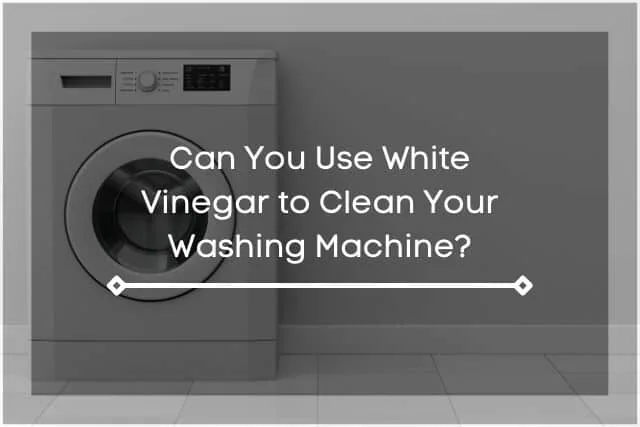
To save money, many people are looking for alternative ways to clean their household appliances.
The high levels of acetic acid in white vinegar are ideal for cleaning and deodorizing washing machines. The vinegar will kill bacteria and mold that cause odors in your washing machine. It also helps to clean off soap residue and grime that accumulates in the washing machine.
By adding white vinegar to your washing machine, you can clean it out using the self-cleaning cycle or a long, hot cycle.
Both top loading and front loading washing machines can be cleaned using a vinegar solution.
Acetic acid is a powerful cleaning agent that will dissolve soap residues and other grime.
Can You Use Wine Vinegar (red or white) to Clean Your Washing Machine?
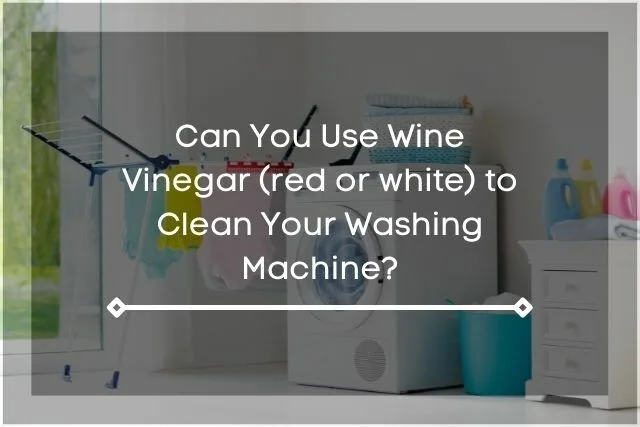
There are always new ways of cleaning household appliances popping up all over the internet.
While it is fine to clean your washing machine with white vinegar, red vinegar has a much stronger smell and it can linger in the washing machine after it has been used. To avoid unnecessary smells and stains, rather stick with only using white or spirit vinegar when cleaning your washing machine.
Red vinegar usually has additives and dyes that can stain clothing. For this reason, it is not advisable that you use it to clean a washing machine. You run the risk of some of the vinegar remaining behind in the washing, causing stains on your light-colored clothing and linen.
If you are struggling to clean your washing machine, you can combine white vinegar and bicarbonate of soda. This makes a potent cleaning agent that cuts through most stains. It also kills germs and removes odors caused by bacteria.
Can You Use Malt Vinegar to Clean Your Washing Machine?

When looking for vinegar to clean your washing machine, be careful which one you choose as it can sometimes have dire consequences.
Malt vinegar is identifiable by its brownish-red color and strong “fish and chips” smell. It is not suitable to use for cleaning washing machines as it stains clothing and leaves an unpleasant smell. Rather, use white vinegar to clean a washing machine as it is much less smelly and does not stain.
White vinegar is a more refined version of malt vinegar and has fewer contaminants.
While white vinegar is used to remove stains, malt vinegar produces stains that are hard to remove. You do not want it anywhere near your clothing or linen.
Can You Use Distilled Vinegar to Clean Your Washing Machine?
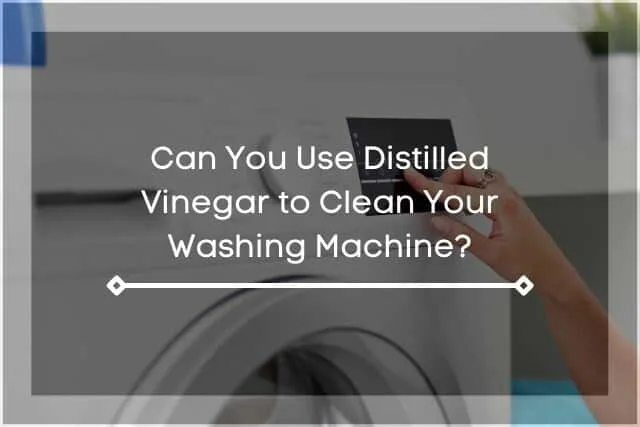
Vinegar has been used for centuries as an effective cleaning agent.
Distilled vinegar is suitable for cleaning washing machines. You can add it to the soap dispenser or you can put it in a spray bottle. Spray the surfaces and then wipe the vinegar off with a cloth. As vinegar is acidic, it can attack rubber components that will eventually need replacement.
While vinegar is environmentally-friendly, many washing machine cleaners work as well if not better, and are safe for the environment.
As vinegar can damage the rubber components over time, it is better to use a non-destructive cleaner that will not harm your washing machine.
That being said, using vinegar to clean your washing machine occasionally is not going to destroy it, so as long as it is not used regularly, you’ll be fine.
So long as you rinse out the washing machine with clean water after using the vinegar, it will be fine. Problems arise when you let the washing machine stand after you’ve used vinegar to clean it and then don’t use it to wash clothing or linen for some time. That will allow any vinegar left in the system to stand. The acid will then start to eat away at the rubber components.
Can You Use Apple Cider Vinegar to Clean Your Washing Machine?
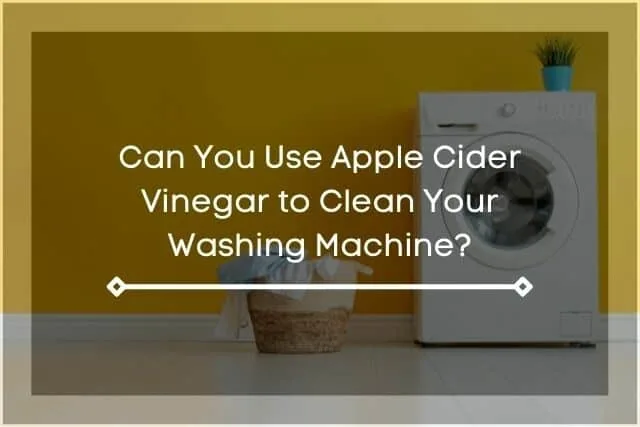
In the search for alternative cleaning materials, apple cider vinegar is an ideal candidate.
Apple cider vinegar or ACV is great for removing dirt and killing germs. This makes it an ideal cleaning agent for your washing machine. It can be an expensive option, so using ordinary white vinegar is a better option. You can add 2 cups of ACV to your soap dispenser to clean the washing machine.
Apple cider vinegar is not toxic and can kill both bacteria and mold. Both of these can cause odors in the washing machine. So, using ACV will prevent odors.
Add the ACV to your washing machine and run a long, hot cleaning cycle. Once the cycle has been completed, your washing machine will be clean and deodorized.
For an effective cleaning agent, you can add bicarbonate of soda to the ACV to enhance its cleaning ability.
Can You Use Vinegar and Soda Crystal to Clean Your Washing Machine?
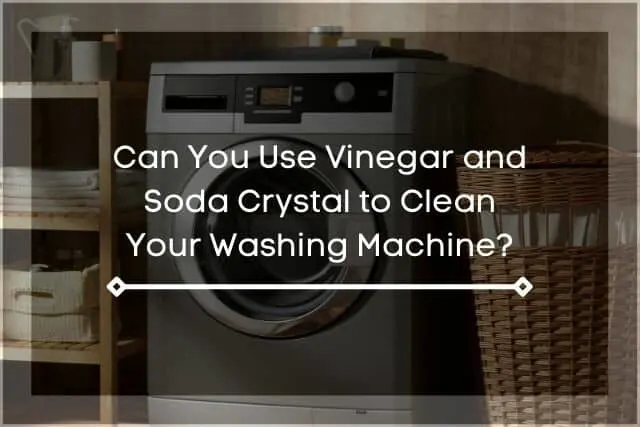
It is not always a good idea to combine cleaning agents as they can interact with each other to damage your washing machine.
You can add vinegar to soda crystals if your washing machine is particularly dirty. If the water in your location is hard, then adding 250 ml of white vinegar to the drum with the crystals in it will help to remove limescale build-up. It will also help to kill bacteria that cause bad odors.
After you have added your soda crystals and white vinegar, set the washing machine on its self-cleaning cycle, or if it doesn’t have one, use the longest and hottest cycle.
While you can add the soda crystals to each wash, it is not advisable to add vinegar to your normal washing cycles.
Rather, use the vinegar and soda crystals every 6-8 weeks to ensure that your washing machine is kept mold and bacteria-free.
How to Clean Your Washing Machine With Vinegar Properly

While commercial washing machine cleaning agents are effective at keeping your washing machine clean, many people prefer to use a more environmentally-friendly option.
Add vinegar to the washing machine’s soap dispenser and set it on its self-cleaning cycle. If it does not have a self-cleaning cycle, then select the longest hot wash available. Allow the washing machine to run for a few minutes and then pause the cycle to allow the vinegar to work.
After an hour, let the cycle continue. Once it is finished, your washing machine should be sparklingly clean.
You can also remove the soap dispenser drawer and clean it separately by using a brush and vinegar in a spray bottle. You can also spray the inside of the washing machine drum as well as the door seal.
As mold and bacteria grow on the rubber door seal, it is best to ensure that these are properly clean by giving them a good scrub before setting the self-cleaning cycle.
How Much Vinegar to Clean Your Washing Machine?

The quantity of cleaning material you use will vary depending on the size of your washing machine.
You will need at least 2 cups of distilled white vinegar to clean your washing machine. This excludes vinegar you may use to spray down the inside of the drum and the soap dispenser. Once you’ve added the vinegar to the soap dispenser, you’ll need to set the self-cleaning cycle or a long hot cycle.
If your soap dispenser is very dirty with a great deal of soap residue, then you need to remove it from the washing machine and spray it with vinegar, and then scrub the residue away with a toothbrush.
If your rubber door seal is overgrown with mold, then you need to spray it down with vinegar and allow it to soak into the moldy areas before wiping it away. This may take a few tries before all the mold is gone.
Very dirty washing machines may take as much as 500ml of vinegar to clean. You can minimize the use of vinegar by making cleaning a regular part of your washing machine maintenance.
This way you will avoid having to deal with thick residues and large amounts of mold.
How Often Should You Clean Your Washing Machine With Vinegar?

Regular maintenance will extend the life of your washing machine. And cleaning both the interior and exterior will help to prevent odors, mold, and bacterial growth.
This content is owned by Wabi Sabi Group and was first published on Apr 29, 2022..
Manufacturers recommend that you clean your washing machine at least once a month or every 30 cycles. Depending on how often you use your washing machine, you can extend this to once every 2 months, so long as you allow the washing machine drum to dry out with the door open after each wash.
To clean your washing machine, remove any washing and then take the soap dispenser drawer out. Place it in the sink and spray it down with vinegar. You can then use a toothbrush to scrub the soap dispenser. Be sure to remove all the soap residue that has built up over the weeks of use.
Once the soap dispenser is clean, replace it in the washing machine and open the washing machine door.
Spray the inside of the drum with vinegar and, using a dry cloth, wipe the entire interior.
Next, spray vinegar on the rubber door seal, making sure to get the vinegar into all the folds. Mold usually grows in the folds of the door seal, so you will have to use a brush to remove it. This is vital as the mold is usually responsible for most of the unpleasant odor coming from the washing machine.
Remember to give the glass a good clean too before closing the door and adding 2 cups of vinegar to the soap dispenser. Most newer washing machines have a self-cleaning cycle that can last for up to 4 hours.
If your washing machine doesn’t have a self-cleaning cycle, then you can choose the longest, hottest cycle that is available on the selector. If you have not cleaned the washing machine before, you may wish to add a ½ cup of bicarbonate of soda to the drum. The bicarbonate of soda will help to cut through any grime and grease inside the washing machine.
Switch the washing machine on and allow the cycle to run for a few minutes. When the machine has run for a little while, pause the cycle and let the vinegar mixture sit inside the washing machine for about an hour.
This will allow the vinegar and bicarbonate of soda mixture to cut through the soap residue and other grime inside the washing machine. It also gives the acid in the vinegar time to kill off any bacteria that may be circulating in the washing machine.
After an hour, switch the cycle back on and allow the machine to complete the cleaning process.
This article was first published on Apr 29, 2022 by Wabi Sabi Group..
When it stops, open the door and allow the drum to dry in the circulating air. This helps to prevent mold growth and any odors will dissipate.
Repeat the cleaning process every 1-2 months or sooner if you use the washing machine more often.
As vinegar can eat away at the rubber components and pipes in the washing machine, you should limit the number of times you use vinegar to clean the washing machine. Rather use a commercial cleaner most of the time and only occasionally use vinegar.
Related Articles
Can You Use Baking Soda To Clean a Washing Machine?
What Can You Use to Clean Washing Machine?
WabiSabi Group is the owner of this article and was published on Apr 29, 2022 and last modified on .
